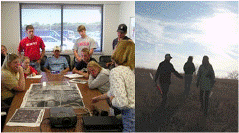Environmental and Sustainability Studies Program

Department of Environmental Studies: Undergraduate Student Theses
Date of this Version
Spring 5-2019
Document Type
Thesis
Abstract
Agriculturally intensive areas such as Nebraska are faced with a growing threat: groundwater nitrate pollution caused by years of applying nitrogen based fertilizer. Nitrate pollution can be attributed to several factors such as manure from cattle ranching and wastewater plants, but Nebraska’s main threat is derived from years of leached nitrogen fertilizer. When nitrogen fertilizer is applied it has one of several fates: plant uptake, volatilization, leaching or run-off. When nitrates leach beyond the plant root system, they are unable to be absorbed by the plant and ultimately move slowly towards the regional ground water table. While nitrate accumulation in the vadose zone is a complex issue with localized contributing factors, understanding nitrate accumulation in the vadose zone helps communities to plan for potential water quality issues in the future. In 2017, staff from the Lower Platte South Natural Resources District (LPSNRD) sampled 8 public water supply wells in Waverly, NE and found that 50% of those wells had nitrate concentrations above 5 mg/L, indicating that the Waverly WHPA exceeded the Phase II ground water quality trigger for the LPSNRD (Ehrman, et al., 2017). A Drinking Water Protection Plan calling for vadose zone soil core testing was implemented and this study quantifies the nitrate concentrations at 7 vadose zone core locations in Waverly, Nebraska while exploring factors such as fertilizer application rates and land use that may attribute to vadose zone nitrate accumulation.
Included in
Environmental Education Commons, Natural Resources and Conservation Commons, Sustainability Commons

